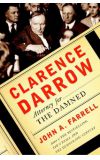
19 Jun 2011 05:07:32
"No one then perceived that this was the birth of the grandest legal career in American history," writes John A. Farrell in "Clarence Darrow: Attorney for the Damned."
It's praise that can be questioned, but Darrow adhered faithfully to a lifelong principle: that any legal maneuver was justified to save a human from the death penalty. Farrell shows him repeatedly guiding hated defendants from crime to punishment, or acquittal.
His greatest victory on that principle was a worldwide sensation.
Richard Loeb, 18, was the youngest graduate in the history of the University of Michigan. Nathan Leopold, 19, was a law student at the University of Chicago about to transfer to Harvard.
The two college students from wealthy Jewish families confessed to the thrill murder of 14-year-old Bobby Franks, beating in his head with a heavy chisel. The 1924 trial attracted worldwide attention. Girls swooned over the handsome teenagers. Even Ruby, Darrow's wife, thought them "adorable."
Farrell's account seems based on the view that the mercy sentences of life imprisonment for Leopold and Loeb were due in large part to the prosecutor's ill-advised hints that their families' wealth and influence had procured a friendly judge. Darrow eloquently argued that Illinois had never hanged anyone under 24 who pleaded guilty.
His last and arguably most publicized case had nothing to do with crime.
It pitted him against former Secretary of State William Jennings Bryan, who was helping prosecute teacher John Scopes under a Tennessee statute that outlawed evolution in public schools — the so-called "Monkey Trial" — held in 1925.
Darrow was a professed agnostic who could use colorful religious language to plead mercy for defendants. Now he entertained himself and a worldwide audience by showing Bryan's ignorance of the Biblical creation story while proclaiming devotion to it. The last question Bryan couldn't answer: How did Eve's serpent get around before God condemned him to crawl eternally on his belly. Did he walk on his tail?

